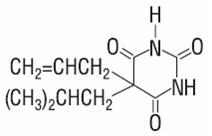Butalbital is well absorbed from the gastrointestinal tract and is expected to distribute to most tissues in the body. Barbiturates in general may appear in breast milk and readily cross the placental barrier. They are bound to plasma and tissue proteins to a varying degree and binding increases directly as a function of lipid solubility.

Elimination of butalbital is primarily via the kidney (59% to 88% of the dose) as unchanged drug or metabolites. The plasma half-life is about 35 hours. Urinary excretion products include parent drug (about 3.6% of the dose), 5-isobutyl-5-(2, 3-dihydroxypropyl) barbituric acid (about 24% of the dose), 5-allyl-5(3-hydroxy-2-methyl-1-propyl) barbituric acid (about 4.8% of the dose), products with the barbituric acid ring hydrolyzed with excretion of urea (about 14% of the dose), as well as unidentified materials. Of the material excreted in the urine, 32% is conjugated.
The in vitro plasma protein binding of butalbital is 45% over the concentration range of 0.5-20 mcg/mL. This falls within the range of plasma protein binding (20%-45%) reported with other barbiturates such as phenobarbital, pentobarbital, and secobarbital sodium. The plasma-to-blood concentration ratio was almost unity, indicating that there is no preferential distribution of butalbital into either plasma or blood cells.
Butalbital and Acetaminophen
Butalbital and acetaminophen combination is a pain reliever and relaxant. It is used to treat tension headaches. Butalbital belongs to the group of medicines called barbiturates. Barbiturates act in the central nervous system (CNS) to produce their effects.
When you take butalbital for a long time, your body may get used to it so that larger amounts are needed to produce the same effects. This is called tolerance to the medicine. Also, butalbital may become habit-forming (causing mental or physical dependence) when it is used for a long time or in large doses. Physical dependence may lead to withdrawal side effects when you stop taking the medicine. In patients who get headaches, the first symptom of withdrawal may be new (rebound) headaches.
Some butalbital and acetaminophen combinations also contain caffeine. Caffeine may help to relieve headaches. However, caffeine can also cause physical dependence when it is used for a long time. This may lead to withdrawal (rebound) headaches when you stop taking it.
Butalbital and acetaminophen combination may also be used for other kinds of headaches or other kinds of pain as determined by your doctor.
